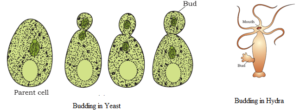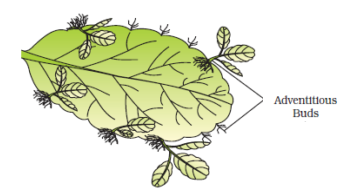Science > Biology > Botany > Reproduction in Plants > Asexual Reproduction in Plants
In this article, we shall study asexual reproduction in plants.
Reproduction:
Reproduction is defined as a biological process in which an organism gives rise to young ones (offspring) similar to itself. The offspring grow, mature and in turn produce new offspring. Thus, there is a cycle of birth, growth and death. Reproduction enables the continuity of the species, generation after generation.
Types of Reproduction:
- Asexual Reproduction: When offspring is produced by a single parent with or without the involvement of gamete formation, the reproduction is asexual.
- Sexual Reproduction: When two parents (opposite sex) participate in the reproductive process and also involve the fusion of male and female gametes, it is called sexual reproduction.
Characteristics of Asexual Reproduction
- In this method, a single individual (parent) is capable of producing offspring. A
- As a result, the offspring that are produced are not only identical to one another but are also exact copies of their parent.
- These offspring are genetically and morphologically identical to parents
- The term clone is used to describe such morphologically and genetically similar individuals.
- Usually followed by organisms with relatively simpler organizations
Types of Asexual Reproduction:
Binary Fission:
In Protists and Monerans, the organism or the parent cell divides into two to give rise to new individuals. Thus, in these organisms cell division is itself a mode of reproduction. Many single-celled organisms reproduce by binary fission, where a cell divides into two halves and each rapidly grows into an adult. e.g., reproduction in Amoeba, Paramecium, Viruses.

Budding:
In yeast, the division is unequal and small buds are produced that remain attached initially to the parent cell which, eventually gets separated and mature into new yeast organisms (cells). e.g reproduction in Yeast and hydra.

Spores Formation:
Members of the Kingdom Fungi and simple plants such as algae reproduce through special asexual reproductive structures. The most common of these structures are zoospores that usually are microscopic motile structures. Other common asexual reproductive structures are conidia (Penicillium), buds (Hydra) and gemmules (sponge).In fungi and algae, specialized asexual reproductive units are formed.

Natural Methods of Vegetative Propagation (Asexual reproduction):
Vegetative Propagation is an asexual method of reproduction in plants. In plants, the units of vegetative propagation such as runner, rhizome, sucker, tuber, offset, bulb are all capable of giving rise to new offspring. These structures are called vegetative propagules. Since the formation of these structures does not involve two parents, the process involved is asexual.
Tuberous Roots:
The roots of such plants have adventitious buds on their surface which sprout under favourable conditions to produce leafy shoots. In Commercial Production these sprouts are separated and planted. Thus many plants can be obtained from a single root. e.g. Sweet potato, Asparagus (Shatavari), Dahlia.

Stem Tubers:
A stem tuber has many notches called ‘eyes’ on their surface. Each eye actually a node and consists of one or more small axillary buds and reduced scale leaves. After dormancy period the eyes which sprout under favourable conditions to produce leafy shoots.
In Commercial Production the tuber is cut into pieces, such that each piece has at least one eye. Then they are grown separately. Thus many plants can be obtained from a single tuber. e.g. Potato, Ginger.

Runners:
Runner develops from the lower axillary bud of the stem and thin elongated cylindrical wire-like structure with long internodes. It creeps on the ground and becomes rooted at the nodes. Shoots are produced from the upper sides of nodes. After getting detached from a parent, such shoots grow as an independent plant. e.g. Cynodon (doobgrass), Fragaria (strawberry), Oxalis.

Leaf:
In bryophyllum, the leaf is succulent with crenate or notched margins. Adventitious buds called epiphyllous buds or foliar buds are formed at notches at the tip of lateral veins. These buds sprout and form leafy shoots and adventitious roots. When such sprout falls on wet soil, they develop into independent plants. e.g. Bryophyllum, Kalanchoe, Begonia.

Hazard due to Water Hyacinth (Terror of Bengal)
- One of the most invasive weeds
- Grows wherever there is standing water
- Drains oxygen from water- leads to the death of fishes.
- Introduced in India because of its pretty flowers & shape of leaves
- Vegetative propagation occurs at a phenomenal rate


Artificial Methods of Vegetative Propagation (Asexual reproduction):
Vegetative methods offer many advantages. As the new generation produced by asexual reproduction is exactly the same as the parent (clone), the good qualities of a race or variety can be preserved indefinitely. If plants have poor viability or prolonged seed dormancy, then vegetative propagation is a rapid, easier and less expensive method of multiplying plants.
The process of growing plants using artificial methods is called artificial propagation.
Layering:

In this method, a young branch is bent and pressed into moist soil. After some time roots develop from the covered part. This is called a layer. Now the branch can be cut from the parent and a new plant is produced. This method is used to propagate plants such as jasmine, black raspberries.
Cutting:
In this method, a branch of plant part (stem, root or leaves) is cut with a node (primary meristem) on it. This piece of a branch is termed a cutting. This cutting is buried in the soil and is watered continuously. This method is the cheapest and convenient method of vegetative propagation.

Grafting:
In this method, the parts of two different plants are joined together in such a way that they unite and continue their growth as one plant. The plant rooted in the soil and on which the part of the other plant is inserted is called a stock. The other plant which is inserted on the stock is called Scion or graft. Budding is a special case of grafting in which a single bid with a small part of bark and living tissue is grafted on another plant.

Tissue culture:

This is a modern method of vegetative reproduction. In this method, a piece of tissue is cut from the plant the removed tissue is called explant. The explant is kept in a nutrient medium under controlled condition. This tissue grows into a mass of cells called a callus. Cells of callus are separated and each cell can give a new plant. These cells are called plantlets. Now the plantlets are grown in a pot of soil. Plants like chrysanthemum and orchids have been propagated by this method.
The significance of Vegetative Propagation:
- It is easy and cheaper method of multiplication.
- The plants like banana, pineapple and grapes which do not produce viable seeds can be propagated by vegetative propagation only.
- In this method, genetically similar plants are formed.
- The yield can be increased by grafting high-yield variety on less yielding variety but which is adapted to the region.
- This is a rapid method of propagation particularly for the plants having a long dormancy period.
- It can be used to get clones of rare plants.
